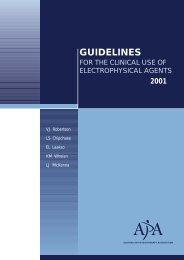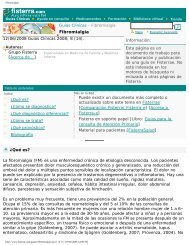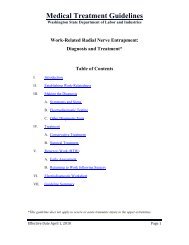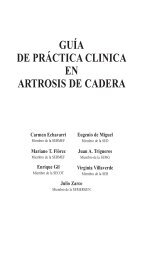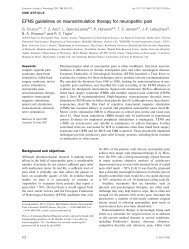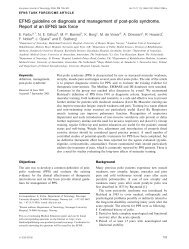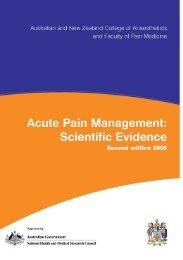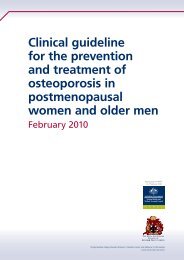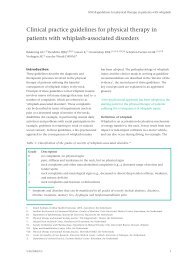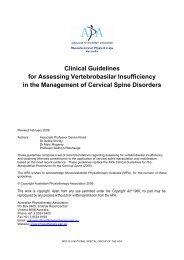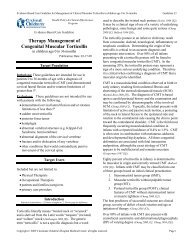<strong>Practice</strong> <strong>Parameter</strong>: Carpal Tunnel Syndromestudy <strong>of</strong> 150 h<strong>and</strong>s in 96 patients suspected <strong>of</strong> CTS. Patients wereincluded in <strong>the</strong> study because at least one EDX test for CTS wasabnormal; patients suspected <strong>of</strong> CTS with normal EDX tests wereexcluded from <strong>the</strong> analysis. The data was used to compare <strong>the</strong> relativesensitivity <strong>of</strong> nine different EDX tests to diagnose CTS. The distalmotor latency was greater than 5 ms in 35% <strong>of</strong> cases <strong>and</strong> greater thanor equal to 4 ms in 55% <strong>of</strong> cases. The D3 to wrist (14 cm)orthodromic median sensory CV was less than or equal to 45 m/s in66% <strong>of</strong> cases. The palm to wrist (8 cm) orthodromic median CV wasless than or equal 45 m/s in 76%. The remaining 24% <strong>of</strong> cases wereassessed by additional EDX tests: <strong>the</strong> median-ulnar latency differencerecorded from D4 was abnormal in 21 <strong>of</strong> <strong>the</strong> remaining 24% <strong>and</strong> <strong>the</strong>centimetric test was altered in all 24%. The median-ulnar latencydifference is simpler to perform than <strong>the</strong> centimetric test <strong>and</strong>, in thisstudy, <strong>the</strong>re was only a small difference in <strong>the</strong> percentage <strong>of</strong> mediannerve abnormalities detected in CTS suspects with <strong>the</strong>se two tests.229. Seror P. The axonal carpal tunnel syndrome. Electroencephalogr ClinNeurophysiol 1996b;101:197-200. Criteria Met (4/6: 1,4,5,6) Source:Medline Search. Abstract: Five patients with clinical symptoms <strong>of</strong>CTS <strong>and</strong> a response to a single corticosteroid injection <strong>of</strong> <strong>the</strong> CT werestudied. Each patient had a normal electrodiagnostic evaluation,including needle examination (C5 to C8T1), distal motor latency,palm to wrist orthodromic sensory conduction velocity, <strong>and</strong> specialtests: median-ulnar latency difference <strong>of</strong> <strong>the</strong> 4th digit, palmarcentimetric technique. A new test is described: <strong>the</strong> orthodromicsensory ultra distal stimulation <strong>of</strong> each digit “at <strong>the</strong> pulp” withrecording over <strong>the</strong> median nerve at <strong>the</strong> wrist for digits 1,2,3,4 <strong>and</strong>over <strong>the</strong> ulnar nerve for digit 5. The test revealed a significantamplitude change (60-90%) in at least two median digits <strong>of</strong> <strong>the</strong>symptomatic h<strong>and</strong> compared to <strong>the</strong> asymptomatic h<strong>and</strong> interpreted as“axonal loss” in <strong>the</strong>se five CTS patients. These findings led to <strong>the</strong>proposal <strong>of</strong> <strong>the</strong> term “axonal CTS.”230. Seror P. Tinel’s sign in <strong>the</strong> diagnosis <strong>of</strong> carpal tunnel syndrome. JH<strong>and</strong> Surg 1987;12-B:364-365. Criteria Met (3/6: 1,2,6) Source:Medline Search.231. Shafshak TS, el-Hinawy YM. The anterior interosseous nerve latencyin <strong>the</strong> diagnosis <strong>of</strong> severe carpal tunnel syndrome with unobtainablemedian nerve distal conduction. Arch Phys Med Rehabil 1995; 76:471-475. Criteria Met (5/6: 1,3,4,5,6). Source: Medline Search.Abstract: The authors concluded that measurement <strong>of</strong> <strong>the</strong> anteriorinterosseous nerve latency (AINL) with surface electrodes has a rolein <strong>the</strong> differential diagnosis <strong>of</strong> severe CTS from o<strong>the</strong>r causes <strong>of</strong>median nerve pathology. The alternative is to perform needle EMGexamination <strong>of</strong> forearm muscles innervated by <strong>the</strong> median nerve.232. Shahani BT, Young RR, Potts F, Maccabee P. Terminal latency index(TLI) <strong>and</strong> late response studies in motor neuron disease (MND),peripheral neuropathies <strong>and</strong> entrapment syndromes. Acta NeurolSc<strong>and</strong> 1979;73(suppl):118. Criteria Met (0/6) (Abstract only) Source:Stevens, 1987.233. Sheean GL, Houser MK, Murray NM. Lumbrical-interosseous latencycomparison in <strong>the</strong> diagnosis <strong>of</strong> carpal tunnel syndrome.Electroencephalogr Clin Neurophysiol 1995;97:285-289. Criteria Met(4/6: 1,3,5,6) Source: Medline Search. Abstract: In 66 h<strong>and</strong>s <strong>of</strong> 45patients with suspected CTS, <strong>the</strong> second lumbrical-interosseous distalmotor latency difference (2LI-DML) was abnormal as frequently (48h<strong>and</strong>s, 72%) as <strong>the</strong> median-ulnar orthodromic mixed nerve palmarvelocity difference.234. *Shurr DG, Blair WF, Bassett G. Electromyographic changes aftercarpal tunnel release. J H<strong>and</strong> Surg Am 1986;11:876-880. Criteria Met(2/6: 1,2) Source: Medline Search.235. *Silverstein B, Fine L, Stetson D. H<strong>and</strong>-wrist disorders amonginvestment casting plant workers. J H<strong>and</strong> Surg Am 1987;12:838-844.Criteria Met (0/6) Source: Medline Search.236. Simovic D, Weinberg DH. Terminal latency index in <strong>the</strong> carpal tunnelsyndrome. Muscle Nerve 1997a;20:1178-1180. Criteria Met (3/6:3,4,5) Source: Medline Search. Abstract: A retrospective studyevaluated <strong>the</strong> usefulness <strong>of</strong> <strong>the</strong> median motor terminal latency index(m-TLI) to diagnose CTS. The m-TLI is a derived measure <strong>of</strong> distalmotor conduction <strong>and</strong> calculated as follows: terminal distance /(proximal conduction velocity × distal latency). The 132 h<strong>and</strong>s <strong>of</strong> 107patients suspected <strong>of</strong> CTS were divided into two groups based on <strong>the</strong>results <strong>of</strong> mixed nerve palmar stimulation studies (normal ≤2.2 ms ormedian to ulnar peak latency difference ≤0.4 ms.) Group I containedpatients with abnormal median palmar peak latencies (likely to haveCTS). while group 2 contains patients with normal median palmarpeak latencies (less likely to have CTS). The m-TLI was less than0.34 in all patients in Group 1 <strong>and</strong> equal or greater than 0.34 in allpatients in Group 2. This retrospective study suggests that <strong>the</strong> m-TLIis a diagnostic test for CTS potentially as useful as <strong>the</strong> median palmarconduction study (see 1999b reference).237. Simovic D, Weinberg DH. The median nerve terminal latency indexin carpal tunnel syndrome: a clinical case selection study. MuscleNerve 1999b;22:573-577. Criteria Met: (6/6: 1,2,3,4,5,6) Source:Medline Search. Abstract: The median terminal latency index (TLI) isa calculated value derived from <strong>the</strong> conventional median motor NCSdata. The TLI is a ratio that adjusts <strong>the</strong> median motor distal latency(DL) for <strong>the</strong> terminal conduction distance (CD) <strong>and</strong> <strong>the</strong> proximalnerve conduction velocity (CV): TLI = terminal CD (mm) /[proximalCV (m/s) × DL (ms)]. The ratio decreases as <strong>the</strong> conduction timeincreases across <strong>the</strong> carpal tunnel. In this prospective study <strong>of</strong> 66patients to assess <strong>the</strong> sensitivity <strong>of</strong> <strong>the</strong> median nerve TLI for <strong>the</strong>diagnosis <strong>of</strong> carpal tunnel syndrome (CTS), clinical <strong>and</strong>electrophysiological evaluations were completed by separate, blindedexaminers. Based on clinical diagnostic criteria, 54 <strong>of</strong> <strong>the</strong> 66 patients(54 h<strong>and</strong>s) were determined to have CTS (CTS group). Control datawere obtained from 19 healthy subjects (38 h<strong>and</strong>s). The mean TLIwas 0.26 ± 0.04 in <strong>the</strong> CTS group <strong>and</strong> 0.43 ±0.04 in <strong>the</strong> control group(P
<strong>Practice</strong> <strong>Parameter</strong>: Carpal Tunnel Syndromecarpal tunnel syndrome. Muscle Nerve 1987;10:99-113. Criteria Met(3/6: 3,5,6) Source: Medline Search. Abstract: The author presents (1)<strong>the</strong> electrodiagnostic findings in 505 cases <strong>of</strong> CTS evaluated at <strong>the</strong>Mayo Clinic from 1961-1980, (2) normal values for median <strong>and</strong> ulnarsensory <strong>and</strong> motor conduction, (3) an EDX protocol for evaluation <strong>of</strong>CTS, <strong>and</strong> (4) a protocol to identify Martin-Gruber anastomosis.244. Stevens JC, Smith BE, Weaver AL, Bosch EP, Deen HG Jr, WilkensJA. Symptoms <strong>of</strong> 100 patients with electromyographically verifiedcarpal tunnel syndrome. Muscle Nerve 1999;22:1448-1456.Background Reference. Source: Medline Search. Abstract: Todetermine <strong>the</strong> symptoms <strong>of</strong> carpal tunnel syndrome (CTS), screeningevaluations were performed in 244 consecutive patients with sensorysymptoms in <strong>the</strong> h<strong>and</strong> <strong>and</strong> unequivocal slowing <strong>of</strong> median nerveconduction at <strong>the</strong> wrist. This yielded 100 patients thought to have noexplanation o<strong>the</strong>r than CTS for <strong>the</strong>ir upper limb complaints. Thesepatients completed a h<strong>and</strong> symptom diagram (HSD) <strong>and</strong> questionnaire(HSQ) about <strong>the</strong>ir symptoms. CTS symptoms were most commonlyreported in median <strong>and</strong> ulnar digits, followed by median digits only<strong>and</strong> a glove distribution. Unusual sensory patterns were reported bysome patients. Based on <strong>the</strong> HSQ, pares<strong>the</strong>sias or pain proximal to <strong>the</strong>wrist occurred in 36.5% <strong>of</strong> h<strong>and</strong>s. The usefulness <strong>of</strong> <strong>the</strong> HSD <strong>and</strong>HSQ for diagnosis was determined by asking three physicians,blinded to <strong>the</strong> diagnosis, to rate <strong>the</strong> likelihood <strong>of</strong> CTS in <strong>the</strong> patientswith CTS <strong>and</strong> in 50 patients with o<strong>the</strong>r causes <strong>of</strong> upper extremitypares<strong>the</strong>sia. The sensitivities <strong>of</strong> <strong>the</strong> independent instruments rangedfrom 54.1% to 85.5%. Based on <strong>the</strong> combined instrument ratings, <strong>the</strong>sensitivity increased to 79.3% to 93.7%.245. Stevens JC, Sun S, Beard CM, O’Fallon WM, Kurl<strong>and</strong> LT. Carpaltunnel syndrome in Rochester, Minnesota, 1961-1980. Neurology1988;38:134-138. Background Reference. Source: Medline Search.246. Steward JD, Eisen A. Tinel’s sign <strong>and</strong> <strong>the</strong> carpal tunnel syndrome. BrMed J 1978;2:1125-1126. Criteria Met (1/6: 3) Source: Golding,1986.247. Szabo RM, Gelberman RH, Dimick MP. Sensibility testing in patientswith carpal tunnel syndrome. J Bone Joint Surg 1984;66A:60-64.Criteria Met (1/6: 1) Source: Borg, 1988.248. Tackmann W, Kaeser HE, Magun HG. Comparison <strong>of</strong> orthodromic<strong>and</strong> antidromic sensory nerve conduction velocity measurement in <strong>the</strong>carpal tunnel syndrome. J Neurol 1981;224:257-266. Criteria Met(6/6: 1,2,3,4,5,6) Source: Uncini, 1989. Abstract: Using ringelectrodes on <strong>the</strong> middle finger <strong>and</strong> subdermal electrodes at <strong>the</strong>midpalm <strong>and</strong> wrist, orthodromic <strong>and</strong> antidromic SNAP latencies wererecorded from 56 h<strong>and</strong>s from 50 CTS patients <strong>and</strong> 32 h<strong>and</strong>s from 32healthy subjects. They report no significant differences in latencies <strong>of</strong>orthodromic <strong>and</strong> antidromic recordings <strong>and</strong> that palmar latencies aremore likely to be abnormal in CTS than digit latencies.249. Tackmann W, Lehman HJ. Relative refractory period <strong>of</strong> median nervesensory fibers in <strong>the</strong> carpal tunnel syndrome. Eur Neurol1974;12:309-316. Criteria Met (4/6: 1,2,4,5) Source: Palliyath, 1990.Abstract: With stimulation on <strong>the</strong> index finger <strong>and</strong> recording at <strong>the</strong>wrist, <strong>the</strong> relative median nerve refractory period was determinedwith paired stimuli in 11 h<strong>and</strong>s <strong>of</strong> eight CTS patients <strong>and</strong> 12 h<strong>and</strong>s <strong>of</strong>eight healthy controls. They found <strong>the</strong> relative refractory period morelikely to be prolonged in patients with CTS as opposed to normalsubjects.250. *Terzis S, Paschalis C, Metallinos IC, Papapetropoulos T. Earlydiagnosis <strong>of</strong> carpal tunnel syndrome: comparison <strong>of</strong> sensoryconduction studies <strong>of</strong> four fingers. Muscle Nerve 1998; 21: 1543-1545. Criteria Met (3/6: 3,5,6) Source: Medline Search. Abstract:Sensory studies <strong>of</strong> four fingers were performed on 72 patients wi<strong>the</strong>arly (distal motor latency



